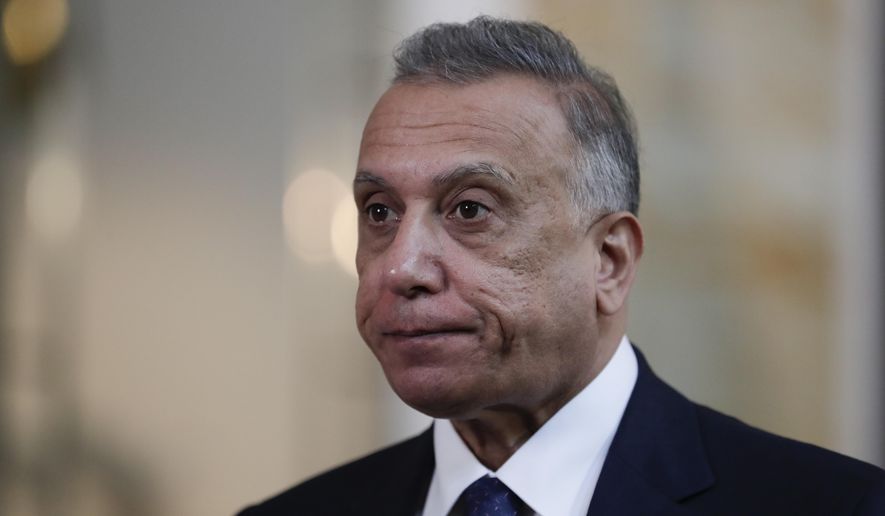The future of the U.S. war in Iraq will come into focus Monday when President Biden meets with Iraqi Prime Minister Mustafa al-Kadhimi at the White House, with the two leaders expected to finalize a withdrawal plan that could fundamentally reshape America’s military role in the Middle East.
Mr. al-Kadhimi made clear in an interview Sunday that he will push the Biden administration to accelerate the withdrawal of the roughly 2,500 U.S. troops still in his country. Those forces have been in Iraq since 2014, when the U.S. founded a multinational coalition to battle the Islamic State group. The terrorist militants at the time controlled a huge swath of territory across Iraq and neighboring Syria.
Iraqi forces can now handle the job themselves, Mr. al-Kadhimi said, and it’s time for the U.S. to transition to a train-and-support role.
“There is no need for any foreign combat forces on Iraqi soil,” the Iraqi leader told The Associated Press in an interview.
“The war against [the Islamic State group] and the readiness of our forces requires a special timetable, and this depends on the negotiations that we will conduct in Washington,” he said. “What we want from the U.S. presence in Iraq is to support our forces in training and developing their efficiency and capabilities, and in security cooperation.”
A new military role in Iraq would likely resemble the Biden administration’s path in Afghanistan, where the U.S. is nearly finished withdrawing all of its 3,500 forces. Just a few hundred Marines will remain in the country to protect the U.S. Embassy and help guard the international airport in Kabul.
Mr. al-Kadhimi would clearly prefer such an arrangement, but the Iraqi prime minister will face pressures of his own Monday.
Mr. Biden almost surely will seek assurances that the Iraqi government will crack down on Iran-backed Shiite militias that routinely carry out rocket attacks and low-level drone strikes against U.S. personnel in the Middle East.
Since Mr. Biden took office in January, at least eight drone attacks and 17 rocket attacks have targeted U.S. troops in Iraq and Syria. An attack this month on an Iraqi air base hosting U.S. forces wounded two Americans.
The attacks have continued despite Mr. Biden‘s order for multiple airstrikes against the militias responsible: Kata’ib Hezbollah and Kata’ib Sayyid al-Shuhada. Those groups are part of the Popular Mobilization Forces, the umbrella organization for Shiite militias based in Iraq. Those two militias receive significant financial and logistical support from Iran.
With the U.S. seemingly headed for the exits, analysts say, Mr. al-Kadhimi likely fears retaliation from Iran should he mount such a crackdown.
“Iraq is not going to take a hard line against things that are not in the interest of Iraq,” said Robert Rabil, a professor at Florida Atlantic University who has written books on the region. “The prime minister is pro-U.S., but he is also a nationalist and pro-Iraq. He knows he can’t make an enemy out of Iran.
“Iraq does not have a political party, so he needs to work in consensus. He wants to improve Iraq but has been faced with a lot of challenges. Using Iraq to settle the score between the U.S. and Iran won’t help,” Mr. Rabil said.
Relations between the U.S. and Iraq have been especially strained since a January 2020 airstrike at Baghdad International Airport that killed Iranian Maj. Gen. Qassem Soleimani, a top security and intelligence commander in Iran. The former head of Kata’ib Hezbollah also was killed in the strike, which angered many Iraqi officials and nearly sparked a war between the U.S. and Iran.
Further complicating the situation, Popular Mobilization Forces militias have played a key role in battling the Islamic State group, which is ostensibly why about 2,500 U.S. forces remain in Iraq.
Troop strength was 3,000 before President Trump cut the number during his final weeks in office.
The U.S. withdrew most of its personnel from Iraq in 2011 under President Obama, but a major American ground combat force returned in 2014 as the Islamic State group built its “caliphate” across a huge swath of Iraq and Syria.
Pentagon and intelligence officials say the Islamic State group has been “territorially defeated” and can no longer field a major ground army, though the organization still has many thousands of fighters and remains capable of carrying out terrorist attacks.
Although Mr. Biden has initiated a pullout from Afghanistan and could soon do the same from Iraq, the U.S. will still have about 900 troops stationed in Syria. There appear to be no immediate plans to bring those forces home.
That means that even if the U.S. withdraws from Iraq, the Iran-backed militias theoretically still could target American forces in Syria or elsewhere across the Middle East.
Pentagon officials have warned that those groups will face retaliation for targeting Americans, presumably even if attacks originate from Iraq.
“We seek to make clear to Iran and Iran-backed militia groups that there will be serious consequences if they continue to attack, or to arm, fund and train militia groups that attack our people,” A Pentagon spokesperson, Cmdr. Jessica McNulty, said in a statement several weeks ago after the most recent U.S. airstrikes on the militias.
“We will take necessary and appropriate measures to defend U.S. personnel, partners and allies in the region,” she said.
• Jeff Mordock can be reached at jmordock@washingtontimes.com.
• Ben Wolfgang can be reached at bwolfgang@washingtontimes.com.




Please read our comment policy before commenting.